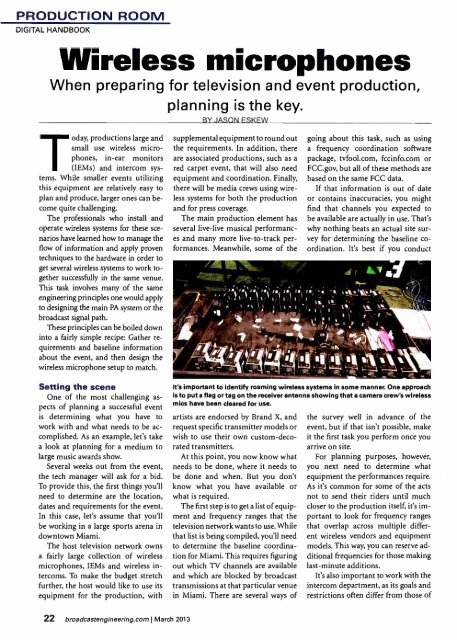ßroadcastEnsineerin - AmericanRadioHistory.Com
ßroadcastEnsineerin - AmericanRadioHistory.Com
ßroadcastEnsineerin - AmericanRadioHistory.Com
You also want an ePaper? Increase the reach of your titles
YUMPU automatically turns print PDFs into web optimized ePapers that Google loves.
PRODUCTION ROOM<br />
DIGITAL HANDBOOK<br />
Wireless microphones<br />
When preparing for television and event production,<br />
planning is the key.<br />
BY JASON ESKEW<br />
Today, productions large and<br />
small use wireless microphones,<br />
in -ear monitors<br />
(IEMs) and intercom systems.<br />
While smaller events utilizing<br />
this equipment are relatively easy to<br />
plan and produce, larger ones can become<br />
quite challenging.<br />
The professionals who install and<br />
operate wireless systems for these scenarios<br />
have learned how to manage the<br />
flow of information and apply proven<br />
techniques to the hardware in order to<br />
get several wireless systems to work together<br />
successfully in the same venue.<br />
This task involves many of the same<br />
engineering principles one would apply<br />
to designing the main PA system or the<br />
broadcast signal path.<br />
These principles can be boiled down<br />
into a fairly simple recipe: Gather requirements<br />
and baseline information<br />
about the event, and then design the<br />
wireless microphone setup to match.<br />
supplemental equipment to round out<br />
the requirements. In addition, there<br />
are associated productions, such as a<br />
red carpet event, that will also need<br />
equipment and coordination. Finally,<br />
there will be media crews using wireless<br />
systems for both the production<br />
and for press coverage.<br />
The main production element has<br />
several live -live musical performances<br />
and many more live -to -track performances.<br />
Meanwhile, some of the<br />
going about this task, such as using<br />
a frequency coordination software<br />
package, tvfool.com, fccinfo.com or<br />
FCC.gov, but all of these methods are<br />
based on the same FCC data.<br />
If that information is out of date<br />
or contains inaccuracies, you might<br />
find that channels you expected to<br />
be available are actually in use. That's<br />
why nothing beats an actual site survey<br />
for determining the baseline coordination.<br />
It's best if you conduct<br />
Setting the scene<br />
One of the most challenging aspects<br />
of planning a successful event<br />
is determining what you have to<br />
work with and what needs to be accomplished.<br />
As an example, let's take<br />
a look at planning for a medium to<br />
large music awards show.<br />
Several weeks out from the event,<br />
the tech manager will ask for a bid.<br />
To provide this, the first things you'll<br />
need to determine are the location,<br />
dates and requirements for the event.<br />
In this case, let's assume that you'll<br />
be working in a large sports arena in<br />
downtown Miami.<br />
The host television network owns<br />
a fairly large collection of wireless<br />
microphones, IEMs and wireless intercoms.<br />
To make the budget stretch<br />
further, the host would like to use its<br />
equipment for the production, with<br />
It's important to identify roaming wireless systems in some manner. One approach<br />
is to put a flag or tag on the receiver antenna showing that a camera crew's wireless<br />
mics have been cleared for use.<br />
artists are endorsed by Brand X, and<br />
request specific transmitter models or<br />
wish to use their own custom -decorated<br />
transmitters.<br />
At this point, you now know what<br />
needs to be done, where it needs to<br />
be done and when. But you don't<br />
know what you have available or<br />
what is required.<br />
The first step is to get a list of equipment<br />
and frequency ranges that the<br />
television network wants to use. While<br />
that list is being compiled, you'll need<br />
to determine the baseline coordination<br />
for Miami. This requires figuring<br />
out which TV channels are available<br />
and which are blocked by broadcast<br />
transmissions at that particular venue<br />
in Miami. There are several ways of<br />
the survey well in advance of the<br />
event, but if that isn't possible, make<br />
it the first task you perform once you<br />
arrive on site.<br />
For planning purposes, however,<br />
you next need to determine what<br />
equipment the performances require.<br />
As it's common for some of the acts<br />
not to send their riders until much<br />
closer to the production itself, it's important<br />
to look for frequency ranges<br />
that overlap across multiple different<br />
wireless vendors and equipment<br />
models. This way, you can reserve additional<br />
frequencies for those making<br />
last- minute additions.<br />
It's also important to work with the<br />
intercom department, as its goals and<br />
restrictions often differ from those of<br />
22 broadcastengineering.com I March<br />
2013
















